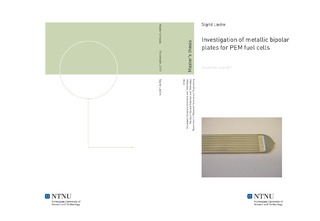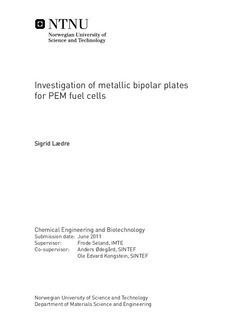| dc.contributor.advisor | Seland, Frode | nb_NO |
| dc.contributor.advisor | Ødegård, Anders | nb_NO |
| dc.contributor.advisor | Kongstein, Ole Edvard | nb_NO |
| dc.contributor.author | Lædre, Sigrid | nb_NO |
| dc.date.accessioned | 2014-12-19T13:25:46Z | |
| dc.date.available | 2014-12-19T13:25:46Z | |
| dc.date.created | 2012-04-20 | nb_NO |
| dc.date.issued | 2011 | nb_NO |
| dc.identifier | 517069 | nb_NO |
| dc.identifier | ntnudaim:6531 | nb_NO |
| dc.identifier.uri | http://hdl.handle.net/11250/248908 | |
| dc.description.abstract | High cost and a short lifetime are the two main reasons why the PEM fuel cell is yet to be commercialized. The bipolar plate in a PEM fuel cell is alone responsible for about 45% of the cost and 85% of the total weight of a single cell. stainless steel has been suggested as material for the bipolar plate because of its good mechanical properties, easy manufacturing and relatively low price. A problem with stainless steel is the Chromium oxide film formed on the surface which causes a high contact resistance. In order to prevent this oxide formation, the stainless steel can be coated. Gold has been suggested as coating, but it is too expensive to be considered a viable alternative. The objective of this thesis was to investigate stainless steel as bipolar plate material for PEM fuel cells. In cooperation with SINTEF polarization tests were done on stainless steel bipolar plates with and without two different coatings; gold and Coating A. The tests were performed in H2SO4 electrolytes with different molarities and additives. Before and after each polarization test Interfacial Contact Resistance (ICR) measurements where done to see how the oxide layer on the stainless steel surface changed during polarization. Gold coated stainless steel was chosen as standard for both the polarization tests and the ICR measurements because of its corrosion resistance.The results obtained from both polarization tests and corresponding ICR measurements showed that the reproducibility was not as good as one had hoped, but this can be explained by low absolute values of the current densities. Gold coated steel proved to be a good standard for the ICR measurements, but due to pitting corrosion the corresponding polarization results were not as promising. The pH in an operating fuel cell was found to be approximately 3.5, and the tests done at different molarities showed that at a lower pH the oxide layer seemed to be thinner and the stainless steel surface thus became more exposed to corrosion. Additions of fluoride and chloride in the amounts expected in an operating fuel cell did not seem to cause any changes for neither the polarization results nor the contact resistance measurements. Stainless steel plates with Coating A showed very small changes in contact resistance after being put trough the polarization tests, but at low potentials the current densities in the polarization test were very high, indicating that components in the coating either catalyzed hydrogen evolution or were reduced themselves. Out of all the ICR measurements, gold coated stainless steel was the only plate satisfying US department Of Energy s (DOE) resistance requirement for bipolar plates of less than 10 mΩ cm2. The stainless steel plates with Coating A were close to DOE s requirements for both corrosion current and contact resistance. Non-coated stainless steel was ruled out as bipolar plate material due to high contact resistance measurements. | nb_NO |
| dc.language | eng | nb_NO |
| dc.publisher | Institutt for materialteknologi | nb_NO |
| dc.subject | ntnudaim:6531 | no_NO |
| dc.subject | MIKJ Industriell kjemi og bioteknologi | no_NO |
| dc.subject | Materialkjemi og energiteknologi | no_NO |
| dc.title | Investigation of metallic bipolar plates for PEM fuel cells | nb_NO |
| dc.type | Master thesis | nb_NO |
| dc.source.pagenumber | 91 | nb_NO |
| dc.contributor.department | Norges teknisk-naturvitenskapelige universitet, Fakultet for naturvitenskap og teknologi, Institutt for materialteknologi | nb_NO |

